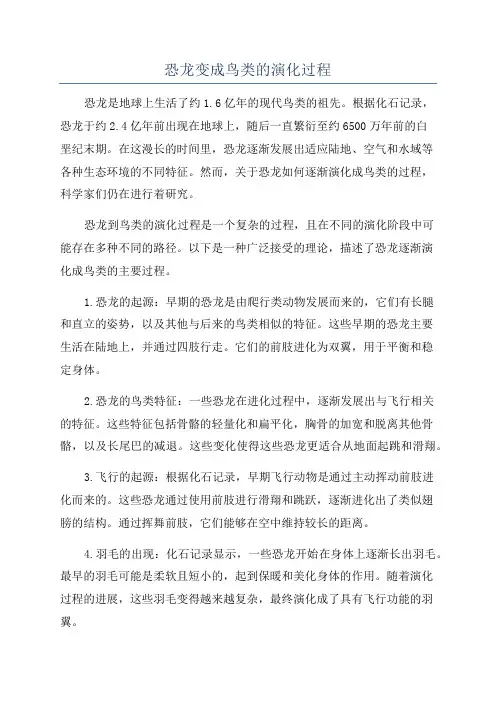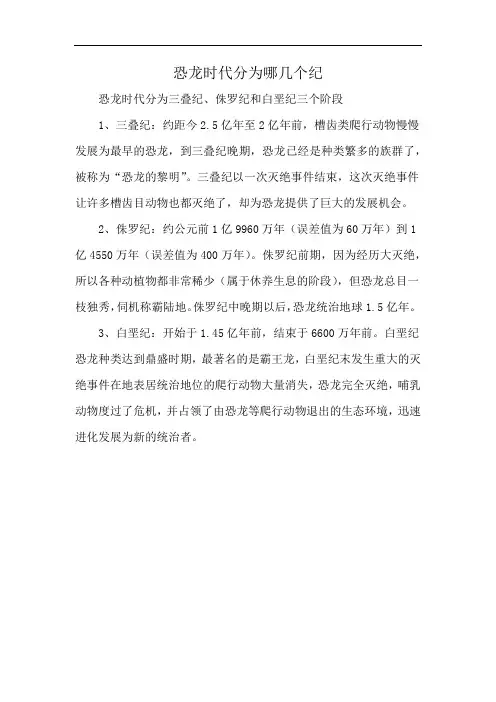恐龙的发展
恐龙的发展ppt_图文

• 气候变迁说。6500万年前,地球气候陡然变化,气温 大幅下降,造成大气含氧量下降,令恐龙无法生存。 也有人认为,恐龙是冷血动物,身上没有毛或保暖器 官,无法适应地球气温的下降,都被冻死了。
• 小行星撞击说。很快获得了许多科学家的支持。1991 年,在墨西哥的尤卡坦半岛发现一个发生在久远年代 的陨星撞击坑,这个事实进一步证实了这种观点。今
亲缘关系。
• 为了提高划水的速度,那时的初龙还进一步改变了 身体的结构,后肢增长,加粗,成为水中的推进器。 逐渐地,腿移到了身体下方。腿的位置变动和后腿的 加长,对这类动物取得生存优势是非常重要的。后来 ,气候变得更加干燥了,这些动物被迫移往陆地上生 活,感觉到长短不齐的四条腿走起路来特别别扭,于 是改用两条后腿行走。长而粗大的尾巴这时正好起到 平衡身体前部重量的作用。由于姿态的改变,它们的 步幅加大了,运动速度也提高了许多,这是向恐龙演 变迈出的关键性一步。
巨霸龙
• 最温顺的恐龙 ——江北重庆龙
江北重庆龙身长只有3-4米,是恐龙中的小 个子。它背上耸立着两排尖刀般的骨板,尾巴上 长着两对剑棘,看上去非常凶猛。其实,它属恐 龙中最温顺的剑龙家族,这些武器只有在受到侵 犯时才动用。对于它背上的两排骨板,多数学者 认为它是防卫武器,还有人说它是警报器,摇动 起来不仅哗哗作响,可吓唬敌人,还能提醒同伴 躲避。
• 蜥臀目分为蜥脚类(Sauropoda)和兽脚类 (Theropoda),蜥脚类又分为原蜥脚类和蜥 脚形类。
• 鸟臀目分为5大类:鸟脚类(Ornthopoda) 、剑龙类(Stegosauria)、甲龙类 (Ankylosauria),角龙类(Ceratopsia)和肿 头龙类(Pachycephalosauria)。
恐龙的发展ppt_图文.ppt
恐龙的演化过程

恐龙的演化过程
1、恐龙祖先是蜥蜴类型物种,二叠纪晚期,生物的演化出现了两个不同的趋势,两个趋势都对地球的历史有深远的影响。
2、恐龙发展为恐龙本系与哺乳类动物,祖先蜥蜴占有一定优势,随时间演变为后续恐龙。
3、初等进化恐龙在石炭纪已经出现,同时出现世界上最早的爬行动物西洛锡安蜥龙类。
4、二叠纪时期,恐龙种类渐趋多样化,形状也开始接近最早的恐龙。
二叠纪是一个比较干旱的时代,沙漠十分常见。
5、三叠纪时期,出现基龙和异齿帆背龙一类群体生活恐龙,同时预示恐龙种族完全进化完毕。
恐龙变成鸟类的演化过程

恐龙变成鸟类的演化过程恐龙是地球上生活了约1.6亿年的现代鸟类的祖先。
根据化石记录,恐龙于约2.4亿年前出现在地球上,随后一直繁衍至约6500万年前的白垩纪末期。
在这漫长的时间里,恐龙逐渐发展出适应陆地、空气和水域等各种生态环境的不同特征。
然而,关于恐龙如何逐渐演化成鸟类的过程,科学家们仍在进行着研究。
恐龙到鸟类的演化过程是一个复杂的过程,且在不同的演化阶段中可能存在多种不同的路径。
以下是一种广泛接受的理论,描述了恐龙逐渐演化成鸟类的主要过程。
1.恐龙的起源:早期的恐龙是由爬行类动物发展而来的,它们有长腿和直立的姿势,以及其他与后来的鸟类相似的特征。
这些早期的恐龙主要生活在陆地上,并通过四肢行走。
它们的前肢进化为双翼,用于平衡和稳定身体。
2.恐龙的鸟类特征:一些恐龙在进化过程中,逐渐发展出与飞行相关的特征。
这些特征包括骨骼的轻量化和扁平化,胸骨的加宽和脱离其他骨骼,以及长尾巴的减退。
这些变化使得这些恐龙更适合从地面起跳和滑翔。
3.飞行的起源:根据化石记录,早期飞行动物是通过主动挥动前肢进化而来的。
这些恐龙通过使用前肢进行滑翔和跳跃,逐渐进化出了类似翅膀的结构。
通过挥舞前肢,它们能够在空中维持较长的距离。
4.羽毛的出现:化石记录显示,一些恐龙开始在身体上逐渐长出羽毛。
最早的羽毛可能是柔软且短小的,起到保暖和美化身体的作用。
随着演化过程的进展,这些羽毛变得越来越复杂,最终演化成了具有飞行功能的羽翼。
5.飞行的完善:恐龙到鸟类的演化还包括体型和骨骼结构的改变。
恐龙的尾巴逐渐变短,使得身体更平衡。
骨骼和骨盆也逐渐发生改变,以适应飞行的需要。
飞行对鸟类的呼吸系统也有影响,它们通过气囊和气道的结构,使得氧气更有效地供给肌肉。
6.恐龙的绝灭与鸟类的继承:约6500万年前的白垩纪末期,恐龙因为其中一种原因而遭受了大规模的灭绝。
然而,一些恐龙的后代在此期间幸存下来,并通过演化逐渐发展成现代的鸟类。
这些鸟类进一步发展出不同的特征,形成了丰富多样的鸟类物种。
恐龙发展简史

恐龙发展简史从19世纪90年代开始的100多年中,先后有俄、美、加等近十个国家和我国的古生物学家、地质学家在二连地区进行过七次大型考察和挖掘。
陆续发现盘足龙、欧氏阿莱龙、鸭嘴龙、似鸟龙等十余种恐龙化石,出土了大量较完整的恐龙骨骼化石。
其中,恐龙蛋化石的发现创我国最早记录。
二连浩特因此成为内蒙古最早载入国际古生物史册的恐龙化石产地,在中国及中亚恐龙研究史上占有重要地位。
1893年,俄国地质学家奥勃鲁契夫院士首次发现了该地层,但没有做更深入的调查。
1922年4月21日,美国纽约自然历史博物馆组成“中亚古生物考察团”,该考察团组织40人、5辆汽车及数十匹骆驼,由张家口出发,4月25日到达二连盐池西驻扎。
在二连地区伊尔丁曼哈组发现了大量哺乳动物化石,在二连盐池达布苏组首次发现了恐龙及恐龙蛋化石,揭开了二连恐龙动物群研究的帷幕。
尤其是恐龙蛋的首次发现,证实了恐龙是卵生的爬行动物。
这项工作进行了10年,有关的考察成果由伯基,格兰杰和吉尔摩分别于1922年、1927年、1933年发表。
发现的恐龙种类有:霸王龙科的欧氏阿莱龙、似鸟龙科的亚洲似鸟龙、蒙古龙属的坦齿蒙古龙、鸭嘴龙科的姜氏巴克龙和蒙古满洲龙以及吉尔摩龙等等。
目前,纽约自然历史博物馆依然陈列着二连达布苏组出土的恐龙化石的正模标本及装架标本。
1930年有9名中国古生物专家参与了该团的考察工作,其中有著名的古生物学家、中国恐龙研究的奠基人杨钟键教授。
古生物学家张席褆教授担任中方团长。
1932年该团结束考察活动回国后,发表了《中亚的新征服》考察报告,立即轰动世界。
这次考察工作,在亚洲及世界古生物化石研究史上均占有重要地位。
1958—1999年,内蒙古地质局先后成立了“呼和浩特幅”1/100万区调队、内蒙古区测队、内蒙古第二区测队等单位,先后在全区开展了1/100万、1/20万、1/5万比例尺的区域地质测量工作。
通过地质测量及调查,在白垩纪地层中采集到大量的恐龙化石,并对其进行了研究和外检。
恐龙哥长的发展趋势包括

恐龙哥长的发展趋势包括
霸王龙是最著名的恐龙和古生物,我们对于霸王龙的研究从来没有停止过。
就在不久之前,古生物学家发表了一项关于霸王龙的新研究,重建了高分辨率的霸王龙生长序列,并且发现霸王龙成长中的关键时期。
霸王龙的一生细分为21个阶段6个时期:
第一个时期是幼年期,包括4个阶段,年龄跨度在0-12岁;
第二个时期是少年期,包括1个阶段,年龄跨度在13岁;
第三个时期是亚成年期,包括2个阶段,年龄跨度在14-17岁;
第四个时期是青年期,包括5个阶段,年龄跨度在18-22岁;
第五个时期是成年期,包括8个阶段,年龄跨度在23-27岁;
第六个时期是后成年期,包括1个阶段,年龄跨度在28岁+;
在获得了精细的生长序列后,古生物学家进行了更加深入的研究,发现霸王龙成长存在两个关键性的阶段:前者是第6阶段,相当于霸王龙15岁时。
就在这短短的一年之内,霸王龙的头骨形态发生了剧
烈的变化,之前狭长的头骨和下颌骨急速变厚变宽,牙齿也变粗,开始具备了成年霸王龙的头骨特征;后者是第8个阶段,相当于霸王龙18岁时,这一年霸王龙进入了青年期,也就是青春期,体重达到了3吨。
这个体重是非常具有标志性的,因为代表着霸王龙正式向巨大结实的超级掠食者转型,之后的十年里它们的体重将再翻两番。
恐龙时代分为哪几个纪

恐龙时代分为哪几个纪
恐龙时代分为三叠纪、侏罗纪和白垩纪三个阶段
1、三叠纪:约距今2.5亿年至2亿年前,槽齿类爬行动物慢慢发展为最早的恐龙,到三叠纪晚期,恐龙已经是种类繁多的族群了,被称为“恐龙的黎明”。
三叠纪以一次灭绝事件结束,这次灭绝事件让许多槽齿目动物也都灭绝了,却为恐龙提供了巨大的发展机会。
2、侏罗纪:约公元前1亿9960万年(误差值为60万年)到1亿4550万年(误差值为400万年)。
侏罗纪前期,因为经历大灭绝,所以各种动植物都非常稀少(属于休养生息的阶段),但恐龙总目一枝独秀,伺机称霸陆地。
侏罗纪中晚期以后,恐龙统治地球1.5亿年。
3、白垩纪:开始于1.45亿年前,结束于6600万年前。
白垩纪恐龙种类达到鼎盛时期,最著名的是霸王龙,白垩纪末发生重大的灭绝事件在地表居统治地位的爬行动物大量消失,恐龙完全灭绝,哺乳动物度过了危机,并占领了由恐龙等爬行动物退出的生态环境,迅速进化发展为新的统治者。
恐龙的形成及发展演化史的英语作文
恐龙的形成及发展演化史的英语作文全文共3篇示例,供读者参考篇1The Formation and Evolutionary History of DinosaursDinosaurs have captivated the human imagination for centuries. Their massive sizes, bizarre anatomies, and dominance over the prehistoric world have made them icons of an era lost to the sands of time. But how did these remarkable creatures come to be? And how did they evolve and diversify over their roughly 165 million-year reign on Earth? In this essay, I will explore the fascinating origins and evolutionary journey of the dinosaurs.The Triassic Period: The Emergence of Dinosaurs (252-201 million years ago)The dinosaurs trace their roots back to the late Triassic period, when the first dinosaur-like reptiles known as dinosauromorphs appeared. These small, bipedal creatures were descendants of the reptilian order Therapsida and closely related to modern crocodiles and birds. Among the earliest true dinosaurs were genera like Eoraptor, Herrerasaurus, andStaurikosaurus, which roamed the semi-arid landscapes of present-day South America and parts of Africa.As the Triassic period progressed, these proto-dinosaurs began to diversify into two major groups: the Saurischia (lizard-hipped dinosaurs) and the Ornithischia (bird-hipped dinosaurs). The Saurischia included the ancestors of massive herbivores like Brachiosaurus and Diplodocus, as well as the fearsome carnivores like Allosaurus and Tyrannosaurus. The Ornithischia, on the other hand, gave rise to the armored Stegosaurs, horned Ceratopsians, and the duck-billed Hadrosaurs.The Jurassic Period: The Rise of the Dinosaurs (201-145 million years ago)The Jurassic period witnessed the true ascendance of dinosaurs as the dominant terrestrial vertebrates on the planet. As the supercontinent Pangea began to break apart, new ecosystems and habitats emerged, allowing dinosaurs to diversify and adapt to various environmental niches.During this time, the iconic long-necked sauropods like Diplodocus and Brachiosaurus flourished, reaching massive sizes and becoming the largest land animals to ever walk the Earth. Carnivorous theropods like Allosaurus and the earliest ancestorsof modern birds also thrived, filling top predator roles in the food chain.The Jurassic also saw the emergence of some of the most bizarre and specialized dinosaur groups. The armored Stegosaurs with their distinctive plates and tail spikes roamed the plains, while the fearsome Ceratopsians with their horns and frills became dominant herbivores.The Cretaceous Period: The Reign of the Dinosaurs (145-66 million years ago)The Cretaceous period marked the zenith of dinosaur diversity and dominance on Earth. As the continents continued to drift apart, new ecosystems emerged, allowing dinosaurs to adapt and evolve into a staggering array of forms.This period saw the rise of the iconic Tyrannosaurus rex, one of the largest and most fearsome carnivores to ever exist. Other notable theropods like Spinosaurus and Giganotosaurus also emerged, competing for dominance in their respective ecosystems.Among the herbivores, the Hadrosaurs (duck-billed dinosaurs) thrived, evolving into a diverse group of species that roamed the lush Cretaceous landscapes. The Ceratopsians alsoreached their peak, with genera like Triceratops and Styracosaurus becoming formidable horned herbivores.The End of an Era: The Cretaceous-Paleogene Extinction (66 million years ago)Approximately 66 million years ago, a massive asteroid or comet struck the Earth in what is now the Yucatán Peninsula of Mexico. This cataclysmic event, known as theCretaceous-Paleogene (K-Pg) extinction event, triggered a series of environmental disasters that ultimately led to the demise of the non-avian dinosaurs.The impact itself unleashed a massive dust cloud that blocked out sunlight, causing a global cooling effect and disrupting photosynthesis. This was followed by intense volcanic activity, further exacerbating the environmental crisis. The combination of these factors destroyed food chains and made survival increasingly difficult for the dinosaurs.While the non-avian dinosaurs perished, a small group of feathered theropod dinosaurs known as Paraves survived the mass extinction event. These feathered dinosaurs, which included early birds like Archaeopteryx, were the ancestors of all modern birds that we see today. In a sense, the birds are the living descendants of the once mighty dinosaurs.The Legacy of DinosaursDespite their extinction millions of years ago, dinosaurs continue to capture our imagination and inspire scientific curiosity. Their fossilized remains, preserved in rocks and sediments around the world, provide invaluable insights into the evolution of life on Earth. Ongoing research and new fossil discoveries continue to reshape our understanding of these ancient giants and their place in the grand tapestry of life.Furthermore, the study of dinosaurs has profound implications for our understanding of modern ecosystems and the potential impacts of environmental changes. By examining the factors that contributed to their extinction, we can better comprehend the delicate balance of life on our planet and the importance of preserving biodiversity.In conclusion, the dinosaurs were not mere relics of a distant past but the protagonists of a remarkable evolutionary story that spanned millions of years. From their humble beginnings as small, bipedal reptiles to their eventual reign as the dominant terrestrial vertebrates, the dinosaurs left an indelible mark on the history of life on Earth. Their legacy lives on, not only in the form of their avian descendants but also in the enduring fascinationand scientific curiosity they inspire in generations of researchers and enthusiasts alike.篇2The Prehistoric Titans: The Formation and Evolution of DinosaursDinosaurs have captivated the imagination of people across generations, from young children to seasoned paleontologists. These prehistoric titans once ruled the earth, leaving behind a rich tapestry of fossilized remains that offer a tantalizing glimpse into their extraordinary world. As a student of natural history, I have been endlessly fascinated by the formation and evolutionary journey of these remarkable creatures, and I am eager to share my understanding of this fascinating subject.The Origin of DinosaursTo trace the origins of dinosaurs, we must delve into the depths of the late Triassic period, approximately 230 million years ago. During this era, the supercontinent Pangaea was beginning to break apart, giving rise to a diverse array of terrestrial ecosystems. It was within this dynamic andever-changing landscape that the first dinosaurs emerged,evolving from a group of reptiles known as the dinosauromorphs.The earliest known dinosaurs were relatively small, bipedal creatures, such as the Eoraptor and Herrerasaurus, which roamed the ancient lands of what is now South America. These early pioneers paved the way for the subsequent diversification and evolution of dinosaurs, setting the stage for their eventual dominance on our planet.The Triassic-Jurassic TransitionAs the Triassic period transitioned into the Jurassic, approximately 200 million years ago, the dinosaur lineage underwent a remarkable evolutionary radiation. This period witnessed the emergence of some of the most iconic and recognizable dinosaur groups, including the long-necked sauropodomorphs, the fearsome theropods, and the armored and plated thyreophorans.The Jurassic period is often referred to as the "Age of Dinosaurs," as these magnificent creatures flourished and diversified, adapting to a wide range of ecological niches. The sauropods, such as the Diplodocus and Brachiosaurus, evolved to become the largest land animals to ever walk the earth,towering over their contemporaries with their massive size and elongated necks.The theropods, on the other hand, were the fearsome predators of the Jurassic, with the likes of the Allosaurus and Ceratosaurus stalking the prehistoric landscapes. These bipedal carnivores possessed powerful jaws, sharp teeth, and agile bodies, making them formidable hunters.The Cretaceous Period: The Reign of GiantsAs the Jurassic period gave way to the Cretaceous, approximately 145 million years ago, the dinosaur lineage continued to evolve and diversify, reaching its pinnacle in terms of size, abundance, and ecological dominance.The Cretaceous period witnessed the rise of the iconic tyrannosaurids, such as the Tyrannosaurus rex, which reigned as the apex predator of its time. These massive theropods possessed powerful jaws capable of delivering bone-crushing bites, and their keen senses and intelligence made them formidable hunters.Alongside the tyrannosaurids, the Cretaceous also saw the emergence of various other fascinating dinosaur groups, including the duck-billed hadrosaurs, the horned ceratopsians,and the armored ankylosaurids. These diverse dinosaurs occupied a wide range of ecological niches, from lush forests to arid deserts, adapting to their environments with remarkable success.The End of an EraDespite their dominance and adaptability, the reign of the dinosaurs came to an abrupt end approximately 66 million years ago, during the Cretaceous-Paleogene (K-Pg) extinction event. This mass extinction, believed to have been triggered by a catastrophic asteroid impact, wiped out nearly three-quarters of all plant and animal species on Earth, including the non-avian dinosaurs.While the exact causes of the K-Pg extinction are still debated by scientists, the prevailing theory suggests that the impact of a massive asteroid in the Yucatán Peninsula unleashed a series of global environmental catastrophes, including extreme climate changes, widespread wildfires, and acid rain. These cataclysmic events likely disrupted the delicate ecosystems upon which the dinosaurs relied, ultimately leading to their demise.The Legacy of DinosaursAlthough the non-avian dinosaurs perished during the K-Pg extinction event, their legacy lives on in the form of their descendants – the modern-day birds. Through the study of fossils and comparative anatomy, scientists have uncovered compelling evidence that birds evolved from a lineage of feathered theropod dinosaurs, such as the Archaeopteryx and Velociraptor.Today, the study of dinosaurs continues to captivate scientists and enthusiasts alike, as new discoveries and technological advancements shed light on these ancient creatures. Fossil excavations, advanced imaging techniques, and molecular analysis have provided unprecedented insights into the anatomy, behavior, and evolutionary relationships of dinosaurs, allowing us to piece together a more comprehensive understanding of their remarkable existence.In conclusion, the formation and evolution of dinosaurs represent one of the most fascinating chapters in the history of life on Earth. From their humble beginnings in the late Triassic to their reign as the dominant terrestrial vertebrates during the Jurassic and Cretaceous periods, dinosaurs have left an indelible mark on our planet. Their fossilized remains serve as a testamentto the incredible diversity and adaptability of life, inspiring awe and scientific curiosity in generations to come.篇3The Formation and Evolutionary History of DinosaursDinosaurs have captivated the human imagination for centuries, their towering frames and fearsome jaws igniting a sense of awe and wonder in children and adults alike. But how did these remarkable creatures come to be, and what was their evolutionary journey like? In this essay, we'll delve into the fascinating world of dinosaur formation and development, tracing their origins from the depths of prehistory to their ultimate demise millions of years ago.The Triassic Period: The Dawn of the DinosaursOur story begins in the Triassic period, approximately 252 to 201 million years ago. During this era, the world was a vastly different place, with a single supercontinent known as Pangea dominating the global landscape. It was in this ancient environment that the earliest dinosaurs emerged, evolving from a group of reptiles called therapsids.These proto-dinosaurs, classified as dinosauromorphs, were relatively small and unassuming creatures, bearing littleresemblance to the gargantuan behemoths that would later roam the Earth. They possessed a distinct set of characteristics, including elongated hindlimbs, light and hollow bones, and an upright posture – adaptations that would prove invaluable in their subsequent evolution.The Jurassic Period: The Rise of the GiantsAs the Triassic period drew to a close, a mass extinction event paved the way for the dinosaurs to truly flourish. Entering the Jurassic period (201 to 145 million years ago), these creatures experienced an extraordinary diversification, evolving into a vast array of species that dominated the terrestrial ecosystems of the time.It was during this era that the iconic sauropods, the largest land animals to ever walk the Earth, emerged. Towering giants like Brachiosaurus and Diplodocus left their indelible footprints across the Jurassic landscapes, their long necks allowing them to graze on the lush vegetation of the time.Alongside the sauropods, theropods – the group that includes the fearsome Tyrannosaurus rex – also diversified, occupying various ecological niches as predators and scavengers. These agile and powerful hunters played a crucial role in shapingthe evolutionary trajectories of their prey, setting the stage for an arms race of adaptations and counter-adaptations.The Cretaceous Period: The Zenith of Dinosaur DiversityAs the Jurassic period transitioned into the Cretaceous (145 to 66 million years ago), dinosaurs continued to thrive and evolve, reaching unprecedented levels of diversity and complexity. This period witnessed the emergence of some of the most iconic and recognizable dinosaur species, including the horned and frilled ceratopsians, the heavily armored ankylosaurs, and the feathered theropods that would ultimately give rise to modern birds.One of the most remarkable discoveries from the Cretaceous period was the existence of feathered dinosaurs, blurring the lines between these ancient reptiles and their avian descendants. Fossils of species like Archaeopteryx and Microraptor provided tangible evidence of the evolutionary link between dinosaurs and birds, forever changing our understanding of the dinosaur lineage.The End of an Era: The Cretaceous-Paleogene Extinction EventDespite their remarkable success and dominance, the reign of the dinosaurs was not destined to last forever. Approximately 66 million years ago, a catastrophic event – widely believed to be the impact of a massive asteroid or comet – triggered a global environmental crisis that would ultimately lead to the extinction of non-avian dinosaurs.This cataclysmic event, known as the Cretaceous-Paleogene (K-Pg) extinction, wiped out an estimated 76% of all species on Earth. The dinosaurs, despite their impressive resilience and adaptability, were unable to withstand the far-reaching consequences of this cosmic collision, succumbing to the rapid and severe changes in their environment.However, this mass extinction also paved the way for the rise of mammals, allowing them to diversify and eventually dominate the terrestrial ecosystems once ruled by their prehistoric predecessors.The Legacy of Dinosaurs: From Fossils to Feathered DescendantsWhile the non-avian dinosaurs may have perished, their legacy lives on in the form of fossils and their feathered descendants – the birds that grace our skies today. Paleontological discoveries continue to shed light on theintricate evolutionary histories of these ancient creatures, revealing new insights into their anatomy, behavior, and ecological relationships.Moreover, the study of dinosaurs has profoundly impacted our understanding of evolution, extinction events, and the complex interconnections between life and the environment. Their captivating story serves as a reminder of the fragility of life on Earth and the importance of preserving and protecting our planet's biodiversity.As we continue to unravel the mysteries of the dinosaurs, their legacy will undoubtedly inspire future generations of scientists, artists, and dreamers, reminding us of the remarkable resilience and adaptability of life on our ever-changing planet.。
龙的演化过程
龙的演化过程龙是一种神秘而古老的生物,它的演化过程令人着迷。
从古代神话传说中的巨龙,到现代文化中的龙形象,这些都是龙演化过程的一部分。
本文将以人类视角,描绘龙的演化历程,并探讨其中的奥秘。
一、起源与进化龙的起源可以追溯到古代的神话和传说中。
在许多文化中,龙都被描绘为巨大的有翅膀的爬行动物,有时会喷火。
然而,真实的龙并非如此。
根据现代科学的认知,龙是一种史前爬行动物,属于蜥脚类恐龙的一种。
它们生活在约1.5亿年前的侏罗纪时期。
二、外形特征的演化龙的外形特征在演化过程中发生了巨大的变化。
最早的龙体型较小,四肢粗壮,行动缓慢。
随着时间的推移,龙的体型逐渐增大,四肢变得更加灵活,适应了更复杂的环境。
尤其是后期的龙,它们体型庞大,拥有强壮的胸肌和巨大的翼膀,能够飞行。
这种演化过程使得龙在狩猎和逃避敌人时具备了更强的生存能力。
三、生态位的变化随着龙的演化,它们的生态位也发生了变化。
早期的龙主要以草食为主,以植物为食。
然而,随着龙体型的增大和翼膀的出现,它们逐渐演化为肉食性动物。
这使得龙能够捕食更大的猎物,如恐龙和其他爬行动物。
龙的食物链地位逐渐提升,成为当时生态系统中的顶级掠食者。
四、智力与文化的发展龙的演化过程不仅体现在生物学上,还体现在智力和文化上。
随着时间的推移,龙的智力逐渐提高,发展出复杂的社会结构和文化。
龙开始学习和传承知识,掌握了火焰的运用和魔法的力量。
在人类文化中,龙被描绘为聪明、有智慧的存在,代表着力量和智慧的象征。
五、与人类的互动龙与人类之间的互动也是龙演化过程的一部分。
在许多神话和传说中,龙与人类存在着复杂的关系。
有些龙被描绘为保护者和守护者,保护人类免受邪恶势力的侵害;而有些龙被描绘为邪恶的存在,与人类对抗。
这种互动反映了人类对龙的敬畏和对未知力量的恐惧,同时也反映了人类与自然界其他生物的关系。
龙的演化过程是一个令人着迷的话题。
通过对龙的起源、外形特征、生态位、智力与文化发展以及与人类的互动等方面的探讨,我们可以更好地理解龙这一古老生物的演化历程。
恐龙的介绍而演化成鸟类的过程作文50字
恐龙的介绍而演化成鸟类的过程作文50字1. 引言1.1 恐龙的起源与演化恐龙是地球历史上一群神秘而古老的生物。
它们起源于3.18亿年前石炭纪晚期,演化至6,500万年前的白垩纪末期。
恐龙以其庞大体型、惊人的多样性和独特的生态角色而闻名于世。
这些巨大动物统治着陆地,并在地球上存在了约1.5亿年之久。
1.2 鸟类的起源与演化鸟类被广泛认为是现代恐龙(非鸟类滑翔小爬行动物)的后裔。
科学家通过对恐龙和鸟类化石的研究,发现了许多共同特征,如空心骨、羽毛、爪子等,证明了这种亲缘关系。
鸟类可以追溯到约1.5亿年前白垩纪中晚期,逐渐发展出各种不同类型和形态。
1.3 研究背景对于恐龙如何演化成现今的鸟类,科学界一直存在着争议和讨论。
通过对恐龙和鸟类遗传、形态以及化石记录的分析与比较,人们开始逐渐认识到这个令人着迷的演化过程。
本文旨在综述恐龙演化成鸟类的关键证据和可能的演化过程,并探讨其对现代科学和技术的启示。
同时,展望未来进一步研究的方向,为我们更好地理解生物进化提供新的视角。
2. 恐龙的特征及分类恐龙是爬行动物,生活在距今约2.3亿年到6500万年前的地球上。
它们具有以下显著特征和分类。
2.1 解剖结构恐龙通常拥有直立的姿势,四肢垂直支撑身体。
它们的骨骼相对轻巧但强壮,并具有空心骨以减轻重量。
恐龙的前肢通常较短,用于抓取和保护自己。
后肢则非常强壮,使它们能够迅速奔跑和捕食。
2.2 化石记录通过对化石的发现和研究,我们可以推测恐龙的外貌和生活习性。
化石记录揭示了恐龙多样化且广泛分布于地球各地。
2.3 不同种类的恐龙根据其特征和特点,恐龙可分为不同种类。
例如,兽脚类恐龙(如暴龙)具有巨大而强壮的后腿和锋利的利爪;鸟臀类恐龙(如三角龙)拥有巨大耸起的髂骨;盗龙类恐龙(如始祖鸟)有翼状的前肢。
总体而言,恐龙具有多样化的形态和特征,并且通过各种分类系统进行了分类。
这些特征和分类为我们理解恐龙演化成鸟类的过程提供了重要线索。
恐龙进化发展史
恐龙进化发展史恐龙是地球上最古老和最成功的动物之一,它们统治了早期的地球,但最终在一系列灾难性事件中灭绝。
本文将探讨恐龙进化发展史,从早期形态的出现到属于恐龙的最后一代的消失。
1、早期恐龙形态的出现在2.4亿年前的三叠纪,恐龙的祖先出现在地球上。
这些早期形态的恐龙都是小型的肉食性动物,体型相对较小,行动迅速。
它们具有爬行动物的特征,例如爪子和长尾巴。
这些早期的恐龙为后来恐龙的进化奠定了基础。
2、巨大化的时代约2亿年前的侏罗纪时代,恐龙开始经历巨大化的过程。
一些恐龙种类逐渐增加了体型,发展出巨大的身躯和长脖子。
例如,梁龙是体型巨大的恐龙之一,被认为是陆地上最大的动物之一。
巨大化使恐龙在竞争激烈的环境中更具优势,它们可以吃更多的食物,对抗掠食者。
3、植食性恐龙的兴起随着时间的推移,植食性恐龙在恐龙群中扮演越来越重要的角色。
它们发展出适应吃植物的牙齿和消化系统,如蜥脚类恐龙和角龙类恐龙。
这些恐龙在地球上生活了数百万年,并演化出不同的物种,适应了各种环境。
4、飞行的恐龙另一个重要的进化形态是飞行的恐龙,也被称为翼龙类。
与现代鸟类不同,翼龙类恐龙拥有独特的翼膜和骨架结构,使它们能够在空中滑翔。
它们是地球上第一批成功飞行的脊椎动物之一,对后来鸟类的进一步演化产生了重大影响。
5、灭绝与终结尽管恐龙在漫长的时间里一直繁衍生息,但它们最终在6500万年前的白垩纪末期灭绝了。
这一时期发生了一系列重大的灾难性事件,包括陨石撞击、火山喷发和气候变化。
这些事件导致了全球范围内的生态系统崩溃,许多物种无法适应恶劣的环境而灭绝,包括恐龙。
总结:恐龙进化发展史是地球生物演化史中的重要篇章。
从早期小型形态到巨大化的进化,再到各种不同的进化分支如植食性恐龙和飞行的恐龙,恐龙在地球上经历了辉煌而多样的时期。
然而,最终它们面临了灭绝的命运,成为了地球历史上的一个谜团。
通过对恐龙进化发展史的研究,我们可以更好地了解生命的起源、演化和终极命运。
- 1、下载文档前请自行甄别文档内容的完整性,平台不提供额外的编辑、内容补充、找答案等附加服务。
- 2、"仅部分预览"的文档,不可在线预览部分如存在完整性等问题,可反馈申请退款(可完整预览的文档不适用该条件!)。
- 3、如文档侵犯您的权益,请联系客服反馈,我们会尽快为您处理(人工客服工作时间:9:00-18:30)。
恐龙的发展恐龙的发展史李广超 2019010022 (中国石油大学地球科学学院)提要:恐龙从距今大约2亿3500万年到6500万年诞生,到6500万年前灭绝,存在了大约两亿年。
它们从弱小逐渐强大,它们曾经昌盛一时,是一方霸主,统治着地球,但是它们同样要遭受着灭亡。
“物竞天择,适者生存”,大自然的选择总是有其原因的,恐龙的繁盛正是适应了环境,而其灭亡,却是因为对环境的不适而最终被淘汰,它的存在因此变成了陈迹。
关键词:恐龙,起源,侏罗纪,发展,灭绝正文:恐龙(Dinosaur)是指生活在距今大约2亿3500万年至6500万年前的一类爬行类动物,支配全球生态系统超过1亿6千万年之久。
一般认为大多数恐龙已经全部灭绝,仍有一部分适应了新的环境被保留下来如鳄类龟鳖类;还有一部分沿着不同的进化方向进化成了现在的鸟类和哺乳类(包括我们人类)。
而科学家们一直不断的探索着恐龙的诞生、发展以及它的灭绝。
大约在两亿年前,一颗由冰、岩石和气体组成的巨球撞向了盘古大陆,导致了由鳄鱼及其亲缘动物占统治地位的三叠纪的结束,侏罗纪也由此开始。
科学家在南极洲的冰地探明了一个巨大的陨石坑,并认定它促成了恐龙的演变。
据认为,这个直径300英里(约合480公里)的大坑是由一个跟伦敦差不多大的小行星造成的,时间可追溯到2.5亿年前,那时地球上的生物大批灭绝,最早的恐龙则应运而生。
科学家认为,在恐龙诞生的初期,恐龙的体形比我们熟知的恐龙体形要小得多,它们还常常受到其他动物的猎杀。
恐龙及现生爬行动物的共同祖先,是像蜥蜴一样的小型动物,名叫“杨氏鳄”,约30厘米长,走起路来摇摇晃晃,靠捕捉虫子为生,它们的后代明显分出两支,一支是继续吃虫子的真正的蜥蜴,另一支是半水生的早期类型的初龙。
其中后者,也就是早期类型的初龙,与恐龙有较为可靠的亲缘关系。
那时的初龙是什么样子呢?我们还是先来看看它的代表——植龙吧。
只需瞧上植龙一眼,就会明白它的外貌与鳄鱼像极了,同样是铠甲护身,就连头骨上也有鳄鱼一样的坑洼。
主要差异是植龙的鼻孔靠近双眼,而鳄鱼的鼻孔位于头的最前端。
植龙与鳄鱼一样是肉食动物,而它们的亲族也有演变成植食性动物的,但无论是吃荤的还是吃素的,早期的初龙类动物,身上都长有骨甲,身后都拖着一条粗大有力的尾巴,它能在碧水潭中起到推波助澜的作用。
星撞击盘古大陆之后,恐龙的天敌和竞争者都消失了,它们的生存压力大大减轻,这产生了两个后果:恐龙到处扩张,足迹遍布全球;恐龙的体形逐渐加大,它们由被捕食者变成了猎捕者。
科学家说,恐龙这一角色的转变是在几千年中完成的。
为了提高划水的速度,那时的初龙还进一步改变了身体的结构,后肢增长,加粗,成为水中的推进器。
逐渐地,腿移到了身体下方。
腿的位置变动和后腿的加长,对这类动物取得生存优势是非常重要的。
后来,气候变得更加干燥了,这些动物被迫移往陆地上生活,感觉到长短不齐的四条腿走起路来特别别扭,于是改用两条后腿行走。
长而粗大的尾巴这时正好起到平衡身体前部重量的作用。
由于姿态的改变,它们的步幅加大了,运动速度也提高了许多,这是向恐龙演变迈出的关键性一步。
不过,在早期的初龙类动物身体条件尚不完善,还不太适应陆地生活的时候,其大部分时间还是生活在水中,以免受到别的动物的惊扰。
一旦身体结构更加完善,真正的恐龙便出现了!这类新的,富有生气的动物在陆地上向似哺乳动物发起了进攻。
“物竞天择。
适者生存”达尔文的进化理论应用在这个时期再适合不过了,恐龙凭借着自身的优势,开始了他们的统治地位,当然,恐龙个体之间,也会存在着残酷的斗争。
正是因为恐龙的四肢能够以直立的姿态行走,有了这个优势,恐龙迅速发展,很快就取得了地球的霸主地位,也留下了很多痕迹,让我们得知它们的存在。
很多人以为恐龙全是高如巨树搬的庞然大物,其实也有不少恐龙体型娇小、不及人类膝盖高呢。
地球上曾出现的陆生生物中,以草食性蜥脚亚目恐龙的体型最庞大,腕龙更是其中的佼佼者。
腕龙重约70吨,身长22米,站起来足足有12米,相当于四层楼那么高!最近人们又挖掘出体型比腕龙更大的恐龙化石—巨龙和超龙。
根据推算,超龙比腕龙大三分之一,生前可能有二十头大象那么重!和这些性情温和的巨兽比起来,美颌龙就显得敏捷轻盈多了。
美颌龙为小型肉食性恐龙,体重可能还不及一只猫重。
而恐龙,也不单单史一种,它分为蜥臀目和鸟臀目。
二者间的区别主要在于其腰带结构:蜥臀目的腰带从侧面看是三射型,耻骨在肠骨下方向前延伸,坐骨则向后延伸,这样的结构与蜥蜴相似;十分难看。
鸟臀目的腰带,肠骨前后都大大扩张,耻骨前侧有一个大的前耻骨突,伸在肠骨的下方,后侧更是大大延伸与坐骨平行伸向肠骨前下方。
因此,骨盆从侧面看是四射型。
(除此之外,还有其他区别。
)蜥臀目又分为兽脚目和蜥脚目,鸟臀目分为鸟脚类、剑龙类、甲龙类、角龙类和肿头龙类。
鸟脚类是鸟臀类中乃至整个恐龙大类中化石最多的一个类群。
它们两足或四足行走,下颌骨有单独的前齿骨,牙齿仅生长在颊部,上颌牙齿齿冠向内弯曲,下颌牙齿齿冠向外弯曲。
它门生活在晚三叠世至白垩纪,全都是素食恐龙。
剑龙类,四足行走背部具有直立的骨板,尾部有骨质刺棒两对,剑龙类主要生活在侏罗纪到早白垩纪,是恐龙类最先灭亡的一个大类甲龙类的恐龙体形低矮粗壮,全身披有骨质甲板,以植物为食,主要出现于白垩纪地层。
角龙类,是四足行走的素食恐龙。
头骨后部扩大成颈盾,多数生活在白垩纪晚期,我国北方发现的鹦鹉嘴龙即属角龙类的祖先类型。
肿头龙类主要特点是头骨肿厚,颥孔封闭,骨盘中耻骨被坐骨排挤,不参与组成腰带,主要生活在白垩纪。
大型爬行类恐龙即出现于中生代早期。
植食性的梁龙和迷惑龙,是体形与体重最大的陆栖动物。
霸王龙是最大的肉食性恐龙。
另有生活在海中的鱼龙与蛇颈龙及生活于空中的翼龙等。
翼龙是一类古老而特殊的飞行爬行动物,几乎与恐龙同时出现在晚三叠世的地球上。
作为第一种能够进行动力飞行的脊椎动物,它们比鸟类早约7000万年飞向蓝天,也是包括鸟类、蝙蝠等三类飞行脊椎动物中唯一绝灭的类群。
在恐龙占领陆地的时代,翼龙则统治了天空。
翼龙在地球成功生存了约1.6亿年之后,与恐龙又几乎同时双双消亡于白垩世末期的生物绝灭事件中。
在动物分类学上,它属于蜥臀目、蜥脚亚目、梁龙科。
除了震龙之外,当时生活在地球上的身体巨大的蜥脚亚目(一般称为蜥脚类)恐龙还包括梁龙科的梁龙(身长26米)、雷龙(身长21米,体重25吨)、超龙(身长42米,肩部高5.19米,臀部高4.58米)、马门溪龙(身长22米)以及腕龙科的腕龙(身长25米,体重30~50吨)等等。
这些巨大的恐龙都是吃植物的,高大的身躯和长长的脖子使得它们可以吃到高树上的叶子。
如此巨大的身材肯定需要特别大的食量,但是这些恐龙却全都长了一个相对来说很小的脑袋和不大的嘴,怎么来满足那么大的食量呢?大概它们只能不停地吃了。
科学家推测,马门溪龙一天要用23个小时的时间来进食!这恐怕也是世界之最了。
爬行类在地球上繁荣了约1亿8千万年左右。
这个时代的动物中,最为大家所熟知的就是恐龙。
人们一提到恐龙,眼前就会浮现出一只巨大而凶暴的动物,其实恐龙中亦有小巧且温驯的小恐龙。
恐龙属脊椎动物爬行类,曾生存在中生代的陆地上的沼泽里,后肢比前肢长且有尾。
其中有许多种好食肉,许多种好食草。
其中体态很小的种类,类似最古之鳄及喙头类,较高级的种类与鸟类相似。
研究恐龙,全凭化石。
古生物学家借助其化石,推测其形态及习性。
根据古生物学家的研究,恐龙就像现生的动物一样:有大的,有小的;有的以两条腿走路;有的以四条腿走路;有的吃植物,有的吃动物;有的皮肤光滑,有的皮肤上有鳞或骨板,更多的有羽毛。
其共同相似之处是:所有的恐龙,脑子都很小(除了鸟及部分肉食恐龙),蛋下在陆地上(所有的恐龙都是如此)。
不过,恐龙的强盛只是暂时的,在6500万年前,在地球上称霸一时的恐龙也因各种不适而走向了灭亡。
而对恐龙灭亡原因,各方学者个持其假说:一、气候变迁说。
6500万年前,地球气候陡然变化,气温大幅下降,造成大气含氧量下降,令恐龙无法生存。
也有人认为,恐龙是冷血动物,身上没有毛或保暖器官,无法适应地球气温的下降,都被冻死了。
二、物种斗争说。
恐龙年代末期,最初的小型哺乳类动物出现了,这些动物属啮齿类食肉动物,可能以恐龙蛋为食。
由于这种小型动物缺乏天敌,越来越多,最终吃光了恐龙蛋。
三、大陆漂移说。
地质学研究证明,在恐龙生存的年代地球的大陆只有唯一一块,即“泛古陆”。
由于地壳变化,这块大陆在侏罗纪发生的较大的分裂和漂移现象,最终导致环境和气候的变化,恐龙因此而灭绝。
四、地磁变化说。
现代生物学证明,某些生物的死亡与磁场有关。
对磁场比较敏感的生物,在地球磁场发生变化的时候,都可能导致灭绝。
由此推论,恐龙的灭绝可能与地球磁场的变化有关。
五、被子植物中毒说。
恐龙年代末期,地球上的裸子植物逐渐消亡,取而代之的是大量的被子植物,这些植物中含有裸子植物中所没有的毒素,形体巨大的恐龙食量奇大,摄入被子植物导致体内毒素积累过多,终于被毒死了。
六、酸雨说。
白垩纪末期可能下过强烈的酸雨,使土壤中包括锶在内的微量元素被溶解,恐龙通过饮水和食物直接或间接地摄入锶,出现急性或慢性中毒,最后一批批死掉了。
七、而最被人们公认的是小行星碰撞说。
1991年,在墨西哥的尤卡坦半岛发现了一个发生在久远年代陨星撞击坑,证明了这一观点。
恐龙从诞生到灭亡的两亿年就此结束,恐龙时代也从此结束了。
科学家对恐龙的研究,主要研究的是恐龙的化石。
恐龙死后,身体中的软组织因腐烂而消失,骨骼(包括牙齿)等硬体组织沉积在泥沙中,处于隔绝氧气的环境下,经过几千万年甚至上亿年的沉积作用,骨骼完全石化而得以保存。
此外恐龙生活时的遗迹,如脚印等有时间也可以石化成化石保存下来。
在蒙古戈壁沙漠中考古的古生物学家们发现了第一个已经矿化的食肉恐龙的胚胎,科学家们推测,这一发现会引导人们认识恐龙生活的整个循环过程。
到目前为止,世界上已发现了6或7枚恐龙胚胎化石,但是它们远不及这一枚保存得完整如初。
这只胚胎蜷曲着占据了椭圆形蛋壳的一部分,从侧面看上去很像一个小恐龙。
连同尾巴在内,胚胎的总长在8英寸左右。
它处于胎儿的状态,头弯得离膝盖很近,一只前爪挡在面部,除了尾部和头部有些缺损外,所有的化石骨骼都是完整的。
有成型的椎骨、骨盆和四肢,全都清晰可见。
纽约的美国自然博物馆的马克·诺莱尔博士,也就是这个胚胎的发现者,在他的实验室里小心翼翼地捧起了这只7500万年前的胚胎化石。
恐龙素以尖利的牙齿、凶悍的利爪和巨大的身躯著称,看到这位恐龙搜寻者面对着这样一个娇贵的宝贝微笑,的确很有趣。
正是科学家们对恐龙化石的发现与深入研究,才使得我们能够认识到恐龙。
参考文献:建一 2001 恐龙灭绝之谜猜想《科学之友:上旬》 2001年第四期恐龙胚胎化石李宇 2019与恐龙同行——与恐龙同行系列之一:进化的恐龙《大自然探索》 2019年第八期王德有冯进城 2019 中国河南恐龙蛋和恐龙化石地质出版社山姆.陪普林著肖华范志臣译 2019 探索恐龙与史前生命光明日报出版社参考网站:/huodong/shaonianwangye/16%A1%A2%BA%D3%C4%CF%CA%A1% D6%D0%D0%C4%C9%D9%C4%EA%CD%F8%D2%B3%C9%E8%BC%C6%BE%BA%C8%FC%CD%C6%BC%F6%D7%F7% C6%B7/%BA%D3%C4%CF%D6%A3%D6%DD%CA%D0%E3%C6%F6%CE%A1%AA%CF%A3%CD%FB%D6%AE%B9%E2 /mysite2/index-old2.htm。
